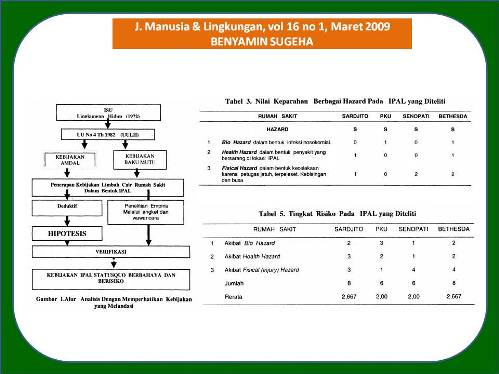
IMPLEMENTASI KEBIJAKAN LIMBAH CAIR RUMAH SAKIT BERBASIS KESELAMATAN DAN KESEHATAN KERJA EVALUASI DAMPAK KEBIJAKAN TERHADAP BAHAYA DAN RISIKO (Implementation of Hospital Liquid Waste Policy Based on Health and Safety Work: Evaluation of Policy Effect)
Benyamin Sugeha(1*)
(1) DPN Asosiasi Ahli K3 Indonesia
(*) Corresponding Author
Abstract
ABSTRAK
Kebijakan internalisasi limbah cair rumah sakit yang diimplementasikan dengan teknologi end-of-pipe dalam bentuk Instalasi pengolahan air limbah (IPAL) di rumah sakit telah memunculkan empirical evidence berupa komplain dari tetangga di sekitar rumah sakit. Adanya paradox internalisasi ini menjadikan kebijakan IPAL rumah sakit menarik untuk diteliti dengan mempertanyakan: bagaimana hasil evaluasi dampak kebijakan ini menyangkut bahaya dan risiko bagi civitas hospitalia. Penelitian kualitaif dengan substansi implementasi kebijakan lingkungan hidup ini merupakan penelitian deskriptif-analitik dalam bingkai analisis kebijakan, dan dilaksanakan di empat rumah sakit yang ada di Daerah Istimewa Yogyakarta (DIY) dengan responden yang diambil secara purposif (purposive sampling). Analisis bahaya dan risiko dipakai panduan dari OHSAS 18001. Hasil penelitian menunjukkan adanya bahaya potensial (potential hazard) pada masing-masing peralatan IPAL, khususnya pada kolam penampungan awal, ekualisasi, dan lumpur. Sedangkan risiko berada pada tingkat substantial.
ABSTRACT
The internalization policy for hospital liquid waste that implemented with the end-of-pipe technology by the bioreactor as the statusquo waste water treatment plant (WWTP), has raised an empirical evidence, in the form of complain by the neighbor. That internalization paradoxs make the internalization policy interesting to be reserached by putting a question as how dangerous and risky are the evaluation impact of the internalization policy, especially for the employee.
Research method: qualitative and quantitative, with form of descriptive-analytic in policy analysis frame point to the impact of the existence of waste water treatment plan (WWTP). The location of observation are four hospitals in Daerah Istimewa Yogyakarta (DIY), with respondents taken purposively. Analysis executed by Hazard and risk assessment guide by OHSAS 18001.
Results show that potential hazard on WWTP is high, especially on the first ponds, equalization ponds, and the sludge. The Risk level in the WWTP are indicated substantial.
Full Text:
ARTIKEL LENGKAP (PDF) (Bahasa Indonesia)Article Metrics
Refbacks
- There are currently no refbacks.
Copyright (c) 2017 Jurnal Manusia dan Lingkungan







